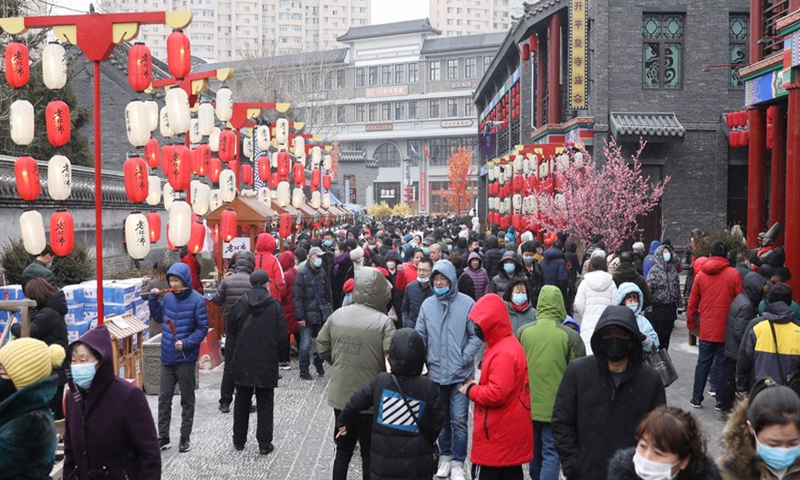
Photo:Xinhua
China's retail sales, a main gauge of consumption - the biggest economic growth driver, rose 12.5 percent in 2021, a turnaround from the 3.9 percent dip in 2020, underscoring the overall resilience of China's spending power in a year full of challenges.
However, a significant slowdown in retail sales growth in the final month of 2021 also underlined risks and challenges ahead for the world's second-largest economy, as the Omicron variant of the COVID-19 is threatening the global recovery.
In 2021, retail sales hit 44.08 trillion yuan ($6.95 trillion) despite sporadic COVID-19 outbreaks, a power crunch and disrupted global supply chains, according to statistics from the National Bureau of Statistics (NBS) released on Monday.
Sales of consumer goods rose 11.8 percent in 2021 compared with the year earlier, while revenue in catering services surged 18.6 percent, according to the NBS.
The solid performance in retail sales drove China's GDP to expand 8.1 percent in 2021, growing the fastest in nearly a decade and landing well above the government's target of more than 6 percent.
Consumption expenditure contributed 65.4 percent to China's 2021 GDP growth, Ning Jizhe, head of the NBS, told a press conference in Beijing.
Compared with a contribution of 54.3 percent to China's economy in 2020, the latest statistics show the role of consumption in economic growth has expanded significantly. The contribution of consumption expenditure in 2021 surpassed the average level of 60 percent from 2013 to 2019, though it was still lower than that of developed economies, where the rate is roughly 70-80 percent.
Behind the robust growth in retail sales are a steady employment situation and a surge in personal disposable income per capita.
In 2021, per capita disposable income reached 35,128 yuan, growing 8.1 percent year-on-year after being adjusted for inflation, the NBS said.
However, the growth of retail sales plunged to 1.7 percent year-on-year in December from 3.9 percent in November, weighed down by COVID-19 flare-ups. In particular, revenue in catering services dropped 2.2 percent in December year-on-year.
The annual retail sales figures are satisfactory but the data for the end of the year showed signs of challenges ahead, Mei Xinyu, a research fellow at the Chinese Academy of International Trade and Economic Cooperation of China's Ministry of Commerce, told the Global Times on Monday.
"December is the traditional shopping season for Chinese people before the Spring Festival, but the slower retail sales growth indicates risks. It will be hard to maintain the heated exports, so the economy must rely on consumption and investment," Mei said.
Liu Xuezhi, a senior macroeconomist at the Bank of Communications, tied the lukewarm retail sales at the end of 2021 to the resurgence of COVID-19 infections, which affected catering, travel and other forms of in-person consumption.
"The spread of the highly transmissible Omicron variant also piled up pressure on the first-quarter economy of 2022, but the impact is likely to weaken starting in the second quarter," Liu said.
Nomura also warned on Monday that "the appearance of the highly transmissible Omicron variant poses a serious threat to the overall economy. Retail sales and the services sector could be severely hit again, with retail sales growth in real terms perhaps falling deeper into negative territory."
The lingering challenges called for more policy support to boost consumption and investment to ensure stable economic growth in 2022, experts said.
Zhang Zhiwei, chief economist of Pinpoint Asset Management, suggested that policymakers may further cut interest rates and the reserve requirement ratio in the first half of the year and introduce a more proactive fiscal policy.
"If the new COVID flare-ups are controlled effectively, [China's] economy will stabilize in mid-year and rise in the second half," Zhang told the Global Times.
Employment is another top priority for policymakers in 2022 to ensure stable development.
In 2021, the surveyed unemployment rate in urban China averaged 5.1 percent, down 0.5 percentage points from 2020, according to the NBS. In the year, the number of newly employed workers in urban areas totaled 12.69 million, above the earlier goal set above 11 million.
The number of migrant workers, a group of people that support China's service industry and infrastructure construction, hit 292.51 million in 2021, up 2.4 percent year-on-year.
Despite tightened regulations for the real estate, private education and online platform sectors, China's overall employment remains outstanding thanks to the resilient performance of China's economy and surprising export performance, Li Chang'an, a professor at the University of International Business and Economics' School of Public Administration, told the Global Times on Monday.
But the pressure on the 2022 employment is still large, because the growth momentum and exports may slow and more than 10 million graduates will all leave burden on the job markets, Li noted.
But analysts said that China still has sufficient policy tools at its disposal to ensure a stable job market, steady growth in consumption and sound economic development in 2022.




